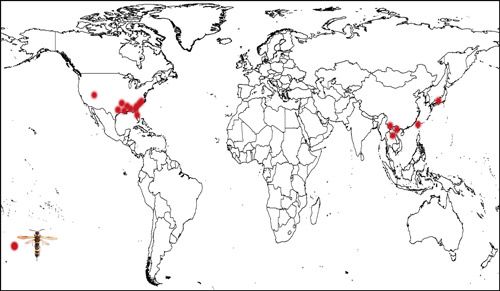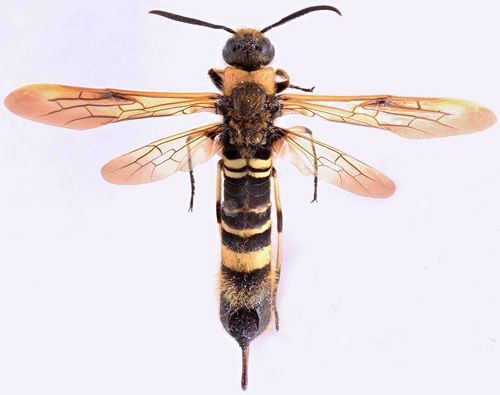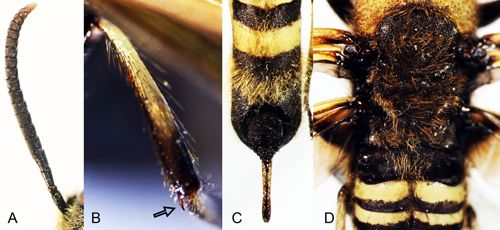Introduction
The family Siricidae consists of 10 extant genera and 122 species worldwide, and is commonly referred to as wood wasps or horntails (Schiff et al. 2012; Smith and Schiff 2002; Morgan 1968; Benson 1950). Four genera have been recorded in Florida (representing six species): Eriotremex Benson, Sirex Linnaeus, Tremex Jurine, and Urocerus Geoffroy (Leavengood and Smith 2013). Eriotremex is a small genus of 13 species that range from Japan and Taiwan to eastern India and Papua New Guinea (Smith 2010) with one species, Eriotremex formosanus, introduced to North America. The earliest records of this introduction are from several counties in Florida and Georgia in 1974 (Smith 1996). It has since become the most common wood wasp in Florida (Smith 1996).
Synonymy
Tremex formosanus Matsumura (1912)
Eriotremex formosanus Benson (1943)
The genus Eriotremex belongs to the subfamily Tremicinae of the family Siricidae. The genus was last reviewed by Smith (2010), who described a new species and provided some new distributional records for the other 12 species. Eriotremex formosanus is the only species of this genus adventitiously introduced to North America.
Distribution
The type species of Eriotremex formosanus was collected from Formosa, the historical Portuguese name for Taiwan. Taiwan wood wasp taxonomist Maa (1949, 1956) recorded Eriotremex formosanus in Vietnam and suggested it may also be present in surrounding areas of Indo-China. Gangrou (1983) found Eriotremex formosanus from Yunnan province in southern China. Togashi and Hirashima (1982) and Togashi and Inoue (2007) recorded Eriotremex formosanus in Honshu, Japan. More recently, Smith (2010) recorded specimens collected in Laos.
Following its introduction into the US, it has been documented throughout much of the Southeast (Alabama, Arkansas, Florida, Georgia, Louisiana, Mississippi, North Carolina, South Carolina, Tennessee, Texas, and Virginia) as well as Utah (Chapin and Oliver 1986; Stange 1996; Smith and Schiff 2002; Schiff et al. 2006, 2012; Warriner 2008).

Credit: You Li, UF/IFAS
Description
As with most wood wasps, Eriotremex formosanus exhibits distinct sexual dimorphism (male and female are quite different in appearance). Adult females have a 3 cm long body with a 4 cm wingspan. The short, blunt, antennae each consist of 20–21 black antennal segments that are sometimes lighter in color at the base and apex. The metatibia bears one apical spur. The females' abdomens consist of black segments, some of which have yellow bands. The thorax is yellow, and long, golden setae (hair-like projections) cover the body throughout.
Originally, Stange (1996) stated that no males of this species have ever been collected. However, Schiff et al. (2006) presented an illustration of the first male from specimens reared in the United States. It was mostly black, with some yellow on the abdominal segments. Leavengood and Smith (2013) illustrated a male with an overall yellow color, with some black markings on most segments of the hind legs. These differences imply that the coloration of the male may be variable.

Credit: You Li, UF/IFAS
Diagnosis
In Florida, there are six species of Siricidae: Eriotremex formosanus (Matsumura), Sirex areolatus (Cresson), Sirex nigricornis Fabricius, Tremex columba (Linnaeus), Urocerus cressoni Norton, Urocerus taxodii (Ashmead), and Sirex noctilio Fabricius. They had been reviewed by Leavengood and Smith (2013) who also provided a key for all of Florida's six Siricidae species.
Eriotremex formosanus differs from other Siricidae species with antennae bearing 20–21 segments (Figure 3A) (other species have either more or fewer); both sexes with only one apical metatibial spur (Figure 3B); and body with long golden hairs (Figures 3C, D).

Credit: You Li, UF/IFAS
Biology
The biology of Eriotremex formosanus is not well known. Adults have been collected year-round in Georgia (Smith and Schiff 2002), though the majority are recorded from April to June and September to November. This suggests two peak flights a year, but few conclusions can be drawn from these data. Some specimens were collected using UV light traps. In the southeastern US, Eriotremex formosanus is abundant in both upland pine-dominated forests and bottomland hardwood forests (Ulyshen and Hanula 2010) and can develop in logs, but strongly prefers snags. Many siricids take two or more years to complete their life cycle, though Eriotremex formosanus may have one or more generations a year, which may explain its rapid spread after introduction to the US (Smith 1996).
Hosts
Whereas most siricid species in North America feed on gymnosperms, Eriotremex formosanus associates most strongly with angiosperms. Host trees in its native range are currently unknown (Smith 2010) but reported hosts in North America include various oaks (e.g., Quercus nigra, Quercus phellos, Quercus alba and Quercus laurifolia), hickory (Carya spp.), and sweetgum (Liquidambar styraciflua). The species has also been reported from two pine species (Pinus palustris and Pinus elliottii) but conclusive evidence the species can complete development in gymnosperms is lacking (Stange 1996; Smith and Schiff 2002). In South Carolina, Ulyshen and Hanula (2010) found Eriotremex formosanus to strongly prefer water oak (Quercus nigra) over sweetgum and found the species to be absent from loblolly pine (Pinus taeda).
Management
Unlike the European woodwasp, Sirex noctilio Fabricius, the Asian woodwasp, Eriotremex formosanus, is not considered an economically important pest because it only attacks dying or dead trees (Warriner 2008). However, the species may someday prove to be a pest and its ecological impacts in North American forests remain unknown (Ulyshen and Hanula 2010). There are no native North American parasitoid wasps or nematodes which could assist in managing Eriotremex formosanus populations. Prevention of the movement of firewood and other wood products into uninfested areas is the most judicious method to control the spread of wood wasps. However, it is not expected to prevent the natural dispersal of the insect. Methyl bromide treatment and heat treatment are two effective methods to kill wood wasp larvae and pupae in the wood.
Selected References
Benson RB. 1950. An introduction to the natural history of British sawflies (Hymenoptera: Symphyta). Transactions of the Society for British Entomology 10: 45–142.
Chapin JB, Oliver AD. 1986. Records of Eriotremex formosanus (Matsumura), Sirex edwardsii Brullé, and Neurotoma fasciata (Norton) in Louisiana (Hymenoptera: Siricidae, Pamphiliidae). Proceedings of the Entomological Society of Washington, 88.
Gangrou X, Jian W. 1983. A study of the Siricidae in China. Supplementary Issue of Forestry Science, 1–29. [in Chinese]
Leavengood Jr JM, Smith TR. 2013. The Siricidae (Hymenoptera: Symphyta) of Florida. Insecta mundi 0309: 1–16.
Maa TC. 1949. A synopsis of Asiatic Siricoidea with notes on certain exotic and fossil forms (Hymenoptera, Symphyta). Musée Heude, Notes d'Entomologie Chinoise 8: 11–189.
Maa TC. 1956. Notes on the genus Eriotremex Benson (Hymenoptera: Siricidae). Proceedings of the Hawaiian Entomological Society 16: 91–94.
Morgan FD. 1968. Bionomics of Siricidae (Hymenoptera). Annual Review of Entomology 13: 239–256.
Schiff NM, Goulet H, Smith DR, Boudreault C, Wilson AD, Scheffler BE. 2012. Siricidae (Hymenoptera: Symphyta: Siricoidea) of the Western Hemisphere. Canadian Journal of Arthropod Identification 21: 1–305.
Schiff NM, Valley SA, LaBonte JR, Smith DR. 2006. Guide to the siricid woodwasps (Hymenoptera) of North America. United States Department of Agriculture Forest Service, Morgantown, West Virginia 102 pp.
Smith DR. 1975. Eriotremex formosanus (Matsumura), an Asian horntail in North America (Hymenoptera: Siricidae). US Department of Agriculture, Cooperative Economic Insect Report 24: 851–854.
Smith DR. 1996. Discovery and spread of the Asian horntail, Eriotremex formosanus (Matsumura) (Hymenoptera: Siricidae), in the United States. Journal of Entomological Science 31: 116–171.
Smith DR. 2010. The woodwasp genus Eriotremex (Hymenoptera: Siricidae), a review and a new species from Malaysia. Proceedings of the Entomological Society of Washington 112: 423–438.
Smith DR, Schiff NM. 2002. A review of the siricid woodwasps and their ibaliid parasitoids (Hymenoptera: Siricidae, Ibaliidae) in the eastern United States, with emphasis on the mid-Atlantic region. Proceedings of the Entomological Society of Washington 104: 174–194.
Stange LA. 1996. The horntails (Hymenoptera: Siricidae) of Florida. Florida Department of Agriculture and Consumer Services, Division of Plant Industry, Entomology Circular 376: 1–3.
Togashi I, Hirashima Y. 1982. Wood wasps or horn tails of the Amami-Oshima Island, with description of a new species (Hymenoptera: Siricoidea). Esakia 19: 185–189.
Togashi I, Inoue S. 2007. Distributional northernmost record of Eriotremex formosanus (Matsumura), and newly recorded woodwasps and sawflies from Fukui Prefecture, Honshu, Japan. Bulletin of the Biogeographical Society of Japan 62: 39–41.
Ulyshen MD, Hanula JL. 2010. Host-use Patterns of Eriotremex formosanus (Hymenoptera: Siricidae) in South Carolina, USA. Entomological News 121: 97–101.
Warriner MD. 2008. First record of the Asian horntail, Eriotremex formosanus (Hymenoptera: Siricidae), in Arkansas, U.S.A. Entomological News 119: 212–213.